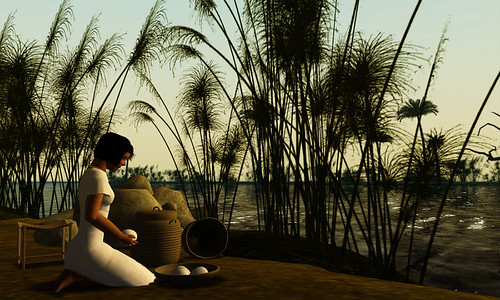Key Dates 1324 BC The figures date from around the time of the death of Tutankhamun, in 1324 BC. They were discovered, along with the rest of the treasures of Tut’s tomb, in 1922. Key People The figure depicted is 18th Dynasty Egyptian pharaoh Tutankhamun himself. They were found by Howard Carter, who located King Tut’s tomb. Key People: Tutankhamun Howard Carter These small statuettes of the famous boy king Tutankhamun astride a panther came in a pair and were located along with 32 other ritual figures inside a black resined wooden box in the treasury section of Tut’s tomb,…
-
-
For thousands of years, scientists from around the world have tried to understand how the Egyptians designed and built the Great Pyramid of Giza – the last remaining of the seven wonders of the ancient world. Now, an architect and researcher at the Norwegian University of Science and Technology (NTNU) says he has the answer to this ancient puzzle. According to Ole Bryn, the Great Pyramid’s building grid was developed based on the prime number seven – and the core of Khufu’s 146.6 meters high monument is likely a step pyramid. Khufu’s Great Pyramid, located on the Giza Plateau, was…
-
The Museum of Fine Arts, Boston and 3D software company Dassault Systèmes have announced they will join forces in a partnership that aims to bring the power of industry as well as experimental 3D to the domain of archaeology. The MFA’s Giza Archives Project digital database will be “the first to benefit from the power of interactive, immersive and multi-platform 3D experiences” as the team intents to create new possibilities for the visualisation of archaeological data for both the scientific community and the general public. (preview video 1 – preview video 2) Visualisation of Archaeological Data for Education and Research…
-
I have spent the majority of the last 6 years working between Egypt and London; during this time my archaeological career has changed track somewhat from working on heritage protection strategies in Luxor to assisting media production companies in producing documentaries set in the historical realm. The journey from archaeologist to televising producer has enabled me to travel both metaphorically and physically between the worlds of the media and archaeology while attempting to be part I hope of both, a sometimes difficult undertaking. Generally I spend most of the year, some eight or nine months in Egypt during the archaeological…
-
I have spent the majority of the last 6 years working between Egypt and London; during this time my archaeological career has changed track somewhat from working on heritage protection strategies in Luxor to assisting media production companies in producing documentaries set in the historical realm. The journey from archaeologist to televising producer has enabled me to travel both metaphorically and physically between the worlds of the media and archaeology while attempting to be part I hope of both, a sometimes difficult undertaking. Generally I spend most of the year, some eight or nine months in Egypt during the archaeological…
-
Four ancient Egyptian artefacts belonging to Tutankhamun, and missing from the Cairo Museum since the January Revolution have been returned, announced Dr. Zahi Hawass, Minister of State for Antiquities, in a statement to the press. The objects returned include the gilded wooden statue of Tutankhamun standing on a skiff throwing a harpoon (JE 60710.1), part of King Tut’s burial treasure. As can be seen in the photos below, the statue suffered damage; a small part of the crown is missing as well as pieces of the pharaoh’s legs. The boat itself never left the Cairo Museum, and the artefact will…
-
A month and a half after the Cairo Museum break-in, Egypt’s Supreme Council of Antiquities has posted online a listing of sixty-three objects that were found to be missing following the looting. Amongst the missing Ancient Egyptian treasures are ritual statues and a fan belonging to King Tut, Yuya’s shabtis, amulets, as well as amulets and jewellery. Final List of Objects Missing from the Egyptian Museum, as released by the SCA, March 15th 2011: Gilded Wooden Figure of Tutankhamun on a Skiff, Throwing a Harpoon (the figure) – Carter no 275c? Gilded Wood Statue of Tutankhamun Wearing the Red Crown…
-
Key Dates 2400 BC The chapel of the tomb of Akhouthotep dates from the Fifth Dynasty, around 2400 BC. It was re-assembled in the Louvre in 1903, by Georges Benedite who was curator in the Egyptian department. Key People Akhethotep was a high dignitary of the latter part of the Fifth Dynasty, succeeding three generations of his family in high office. This chapel from the mastaba (tomb) of Akhethotep was where priests and family of the deceased would have come to offer food and drink to his spirit, and recite texts that would assist him in the afterlife. It is…
-
On March 8th, International Woman’s Day is celebrating its centenary, and the Petrie Museum is joining in by honouring Victorian writer Amelia Edwards, for without her, there may have never have been a ‘Petrie Museum’. Amelia Edwards was a novelist and travel writer, as well as an Egyptologist. After visiting for the first time in Egypt 1873, she wrote a vivid account of her adventure in A Thousand Miles up the Nile. She was the driving force behind the establishment of the Egypt Exploration Fund (now the EES) in 1882 to promote the scientific exploration of Egypt and its monuments.…
-
Egypt’s Minister of Antiquities Affairs, Dr Zahi Hawass, announced today that the missing limestone statue of King Akhenaten, the likely father of Tutankhamun, has been returned to the Egyptian Museum, Cairo. To date, four objects from the preliminary list of missing artefacts have been found; the Heart Scarab of Yuya, a shabti of Yuya, the statue of the goddess Menkaret carrying Tutankhamun, and now the statue of Akhenaten as an offering bearer. Statue of Akhenaten returned The statue of pharaoh Akhenaten is one of the unique statues from the Amarna Period on display at the Egyptian Museum. It is seven…






